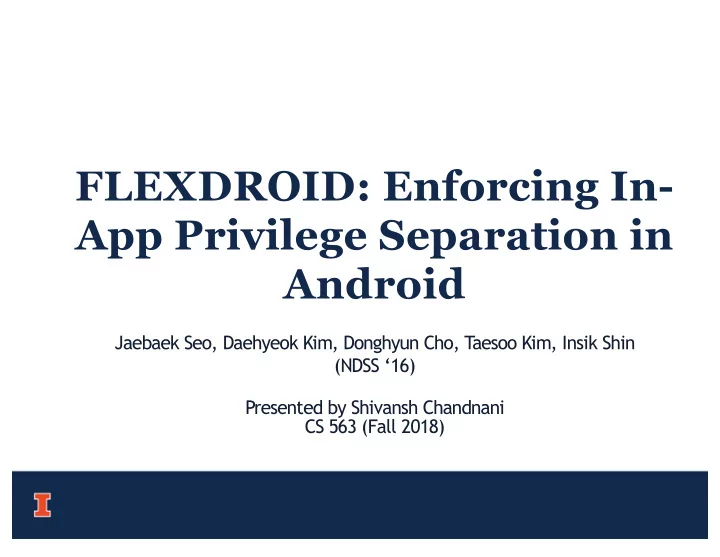

FLEXDROID: Enforcing In- App Privilege Separation in Android Jaebaek Seo, Daehyeok Kim, Donghyun Cho, T aesoo Kim, Insik Shin (NDSS ‘16) Presented by Shivansh Chandnani CS 563 (Fall 2018)
3 rd party libraries are very popular in Android
Can we trust these third party libraries?
Fundamental Problem Third party libraries in Android have the same access to permissions as the host app How can this lead to problems?
Results from analysis of 100,000 apps:
Thoughts about threat model?
Solution In-app privilege separation between a host application and it’s third party libraries
Main challenges • From the analysis of 295 libraries amongst the 100,000 apps – Class inheritance => 71.5% – Java Native Interface => 17.1% – Runtime class loading => 27.9% – Reflection => 49.6%
• From the 20 most popular third party libraries: – 19 use class inheritance – All use atleast one form of dynamic code exection
JNI • Java Native Interface • Allows developers to use libraries in native language • Could improve an app’s performance • Renders memory safety features of Java obsolete
Runtime class loading Source: http://tutorials.jenkov.com/java-reflection/dynamic-class-loading-reloading.html Reflection Source: https://en.wikipedia.org/wiki/Reflection_(computer_programming)
Key Idea Adjusting permissions dynamically whenever an app requests a resource
FLEXDROID Design • Identify the principle using stack tracer • Protect the integrity of the stack trace using tamper resistant memory protection mechanism • Handle dynamic code execution • Are there any alternate designs you think would be more reliable or easier to implement?
Stack tracer • New special purpose thread for each process • Uses secure transmission for data • Amidst the initialization process of an app
Memory isolation • Inspired by ARMLock (CCS ‘14) • Regard JNI code as potentially malicious code – Run it in a separate and restricted memory domain
Protection against dynamic techniques • Store the context of class loader • Store the parent thread’s permissions in case of threads • Basic idea: Use dynamic permissions with context at runtime and creation
Code modified • Experiments performed on Android 4.4.4. Had 40% market share in 2015. • Dalvik replaced with Android Runtime (ART) in Android 5.0. Should the authors have used a different android version to test?
Evaluation • Evaluated 32 top apps across categories • Ran for 10 minutes in both stock android and FLEXDROID. • 5 apps crashed: Waze, Uber, Acrobat Reader, Facebook and UC Browser • Is it necessary for a security modification to be backwards compatible?
Usability • Recompiled apps with flexdroid tag to black third party library’s access • Is this convincing enough that FLEXDROID works as expected? • How about dynamic code execution?
Performance Overhead • Seems to add very little overhead • Any better way to measure performance overhead?
Micro-benchmarks • File open and delete have performance overheads as high as 100%. • JNI methods have very high overhead. • Does this mean the benchmarks with K-9 email app were biased?
Key Takeaways • Android permission system has a fundamental problem with 3 rd party libraries • Third party libraries are using more data than they inform the developer about • FLEXDroid allows to separate the app’s trust from its libraries
Discussion • How does this change with runtime permissions? • Do the sweeping changes required in popular apps disincentivize google to adopt these changes? • Better to provide fake data or no data? • Thoughts on how their performance evaluation could be more convincing?
Recommend
More recommend